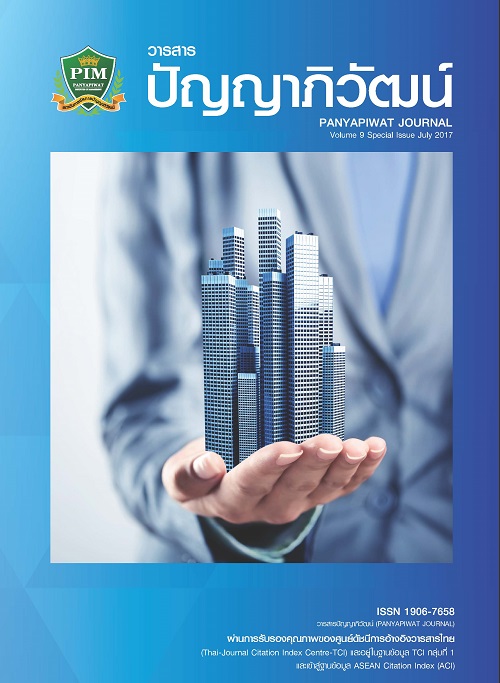COMMUNICATION APPREHENSION AND WILLINGNESS TO COMMUNICATE IN THE ENGLISH LANGUAGE CLASSROOM
Main Article Content
Abstract
This article presents one type of anxieties called communication apprehension and its effect on language learners’ willingness to communicate, particularly speaking abilities. In addition, the applications of relevant research will be discussed how it could be integrated with classroom activities in order to find a practical way to decrease communication apprehension and promote willingness to communicate in classroom.
บทความนี้นำเสนอความวิตกกังวลประเภทหนึ่งที่เรียกว่าความวิตกกังวลด้านการสื่อสารและผลกระทบต่อความเต็มใจที่จะสื่อสารของผู้เรียนภาษาโดยเฉพาะอย่างยิ่งด้านความสามารถในการพูด นอกจากนี้การประยุกต์ใช้ผลของการวิจัยที่เกี่ยวข้องจะนำมาอภิปรายเพื่อหาวิธีที่จะสอดแทรกเข้ากับกิจกรรมในชั้นเรียน เพื่อหาแนวทางในการลดความวิตกกังวลด้านการสื่อสารและส่งเสริมความเต็มใจที่จะสื่อสารในห้องเรียน
Article Details
I and co-author(s) certify that articles of this proposal had not yet been published and is not in the process of publication in journals or other published sources. I and co-author accept the rules of the manuscript consideration. Both agree that the editors have the right to consider and make recommendations to the appropriate source. With this rights offering articles that have been published to Panyapiwat Institute of Management. If there is a claim of copyright infringement on the part of the text or graphics that appear in the article. I and co-author(s) agree on sole responsibility.
References
Al-Tamimi, N. O. M. (2014). Public Speaking Instruction: Abridge to Improve English Speaking Competence and Reducing Communication Apprehension. International Journal, 2(4), 45-68.
Boonsongsup, N. & Rimkeeratikul, S. (2012). Willingness to Communicate and Communication Apprehension in English among Thai Employees. Master’s Thesis, Language Institute, Thammasat University.
Chotipaktanasook, N. (2014). Enhancing Learners’ Willingness to Communicate in English with Social Media. Retrieved July 4, 2017, from http://www.dpu.ac.th/dpurc/assets/uploads/public/jemq7fsotjk80s48ck.pdf
Ellis, R. (2004). Individual differences in second language learning. In A. Davies & C. Elder (Eds.). The Handbook of Applied Linguistices. (pp. 525-551). Oxford: Blackwell Publishing.
Fatemipour, H. & Shirmohamadzadeh, V. (2014). The Relationship between Communication Apprehension and Learners’ Beliefs about Language Learning with EFL University Students’ willingness to Communicate. International Journal of Language Learning and Applied Linguistics World, 7(4), 112-122.
Kasemkosin, B. & Rimkeeratikul, S. (2012). Communication Apprehension of Student Officers at the Royal Thai Air Force Language Center. Language Institute, Thammasat University.
Kopkitthanarot, P. (2011). Communication Apprehension in Public Speaking Among Class 12 English for Careers Students, Thammasat University. Master’s Thesis, Thammasat University.
Krashen, S. (1988). Stephen Krashen’s Theory of Second Language Acquisition. Retrieved April 17, 2017, from http://www.sk.com.br/sk-krash.html
Kuutila, N. (2014). Teachers’ effect on learners’ willingness to communicate in L2. Bachelor’s thesis, Department of Languages English, University of Jyväskylä.
Lucas, J. (1984). Communication apprehension in the ESL classroom: Getting our students to talk. In Melvin, A. & Kenneth, W. Sophia Junior College Faculty Journal, 29, 1-24.
MacIntyre, P. D., Dörnyei, Z., Clément, R. & Noels, K. A. (1998). Conceptualizing willingness to communicate in a L2: A situational model of L2 confidence and affiliation. The Modern Language Journal, 82(4), 545-562.
McCroskey, J. C. (1977). Oral communication apprehension: A summary of recent theory and research. In Rimkeeratikul, S. (2015). Communication apprehension in L1 and L2 of Engineering students in a unique program in Thailand. LEARN Journal: Language Education and Acquisition Research Network, 8(1), 43-52.
McCroskey, J. C. (1983). The communication apprehension perspective. Communication, 12(1), 1-25.
McCroskey, J. C. (1997). Willingness to Communicate, Communication Apprehension, and Self-Perceived Communication Competence: Conceptualizeions and Perspectives. Retrieved July 4, 2017, from http://www.jamescmccroskey.com/publications/bookchapters/020_1997_C3.pdf
Park, H. & Lee, A. R. (2005). L2 learners’ anxiety, self-confidence and oral performance. In 10th Conference of Pan-Pacific Association of Applied Linguistics, Edinburgh University, conference proceedings (pp. 197-208).
Rimkeeratikul, S. (2015). Communication apprehension in L1 and L2 of Engineering students in a unique program in Thailand. LEARN Journal: Language Education and Acquisition Research Network, 8(1), 43-52.
Rimkeeratikul, S. (2016). Communication Apprehension in L2 among MA Students Majoring in English in Bangkok, Thailand. LEARN Journal: Language Education and Acquisition Research Network, 9(2), 14-21.
Rimkeeratikul, S., Zentz, M., Yuangsri, N., Uttamayodhin, P., Pongpermpruek, S. & Smith, S. (2016). Communication Apprehension in L1 and L2 among First-Year Students of a Graduate Program for Executives in a Public University. LEARN Journal: Language Education and Acquisition Research Network, 9(1), 1-10.
Rossman, M. (2010). The Effects of Stress on Short-Term and Long-Term Memory. Retrieved April 17, 2017, from https://trace.tennessee.edu/cgi/viewcontent.cgi?article=2389&context=utk_chanhonoproj
Tom, A. A., Johari, A., Rozaimi, A. & Huzaimah, S. (2013). Factors Contributing to Communication Apprehension among Pre-University Students. Academic Journal of Interdisciplinary Studies, 2(8), 665.


